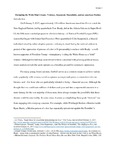| dc.rights.license | In Copyright | en_US |
| dc.creator | Soman, Shaun Michael | |
| dc.date.accessioned | 2017-05-22T14:40:27Z | |
| dc.date.available | 2017-05-22T14:40:27Z | |
| dc.date.created | 2017 | |
| dc.identifier | WLURG38_Soman_WGSS_2017 | |
| dc.identifier.uri | http://hdl.handle.net/11021/33882 | |
| dc.description | Capstone; [FULL-TEXT FREELY AVAILABLE ONLINE] | en_US |
| dc.description | Shaun Michael Soman is a member of the Class of 2017 of Washington and Lee University. | en_US |
| dc.description.abstract | In this paper, I address how womxn, LGBTQ individuals, persons of color, and non-Americans are simultaneously conceptualized or represented within and excluded from the white, hyper-masculine, ultra-nationalist realm of professional football. Despite the manifold connections one may readily discern between the NFL and broad issues such as classism, imperialism, and environmental degradation, I concern myself in this particular work with three general areas of concern. First, I examine how womxn are subjected to and objectified by the “male gaze” as cheerleaders and, in the case of the Legends Football League, players themselves; grounding this portion of my analysis in the work of Laura Mulvey and Naomi Wolf, I demonstrate how the “gridiron” is erected – and vigilantly defended – as a final bastion of masculinity. Second, by deconstructing the language used by play-by-play commentators and referring to Jasbir Puar and Amit Rai’s work on “heterosexual patriotism,” I attempt to establish a link between the overtly sexualized, though hypothetical, violence committed against the “Other” team and the problematic depiction of the terrorist as a sexually perverse, queered individual deserving of actual sexualized violence. Third, by examining the responses to Kaepernick’s national-anthem protest and Beyoncé’s performance during the Super Bowl 50 halftime show, I interrogate how black bodies are interpreted within a space dominated by whiteness. Returning finally to Tom Brady, I demonstrate that while black bodies may be allowed within the domain of football, the NFL’s disproportionate number of white owners, coaches, and quarterbacks – sometimes referred to as “field generals” – reinforces white supremacy. Ultimately, I offer this work as an initial step within a praxis of rendering visible – and responding to – those obscured forms of oppression; in doing so, I stress that we may undertake a collective opposition to the NFL concurrently alongside other forms of resistance. | en_US |
| dc.format.extent | 34 pages | en_US |
| dc.language.iso | en_US | en_US |
| dc.rights | This material is made available for use in research, teaching, and private study, pursuant to U.S. Copyright law. The user assumes full responsibility for any use of the materials, including but not limited to, infringement of copyright and publication rights of reproduced materials. Any materials used should be fully credited with the source. | en_US |
| dc.rights.uri | http://rightsstatements.org/vocab/InC/1.0/ | en_US |
| dc.subject.other | Washington and Lee University -- Capstone in Women's, Gender, and Sexuality Studies | en_US |
| dc.title | Disrupting the White Man's Game: Violence, Hegemonic Masculinity, and an American Pastime | en_US |
| dc.type | Text | en_US |
| dcterms.isPartOf | RG38 - Student Papers | |
| dc.rights.holder | Soman, Shaun Michael | |
| dc.subject.fast | National Football League | en_US |
| dc.subject.fast | Sex discrimination in sports | en_US |
| dc.subject.fast | Racism in sports | en_US |
| dc.subject.fast | Intersectionality | en_US |
| local.department | Women's, Gender, and Sexuality Studies | en_US |
| local.scholarshiptype | Capstone | en_US |
